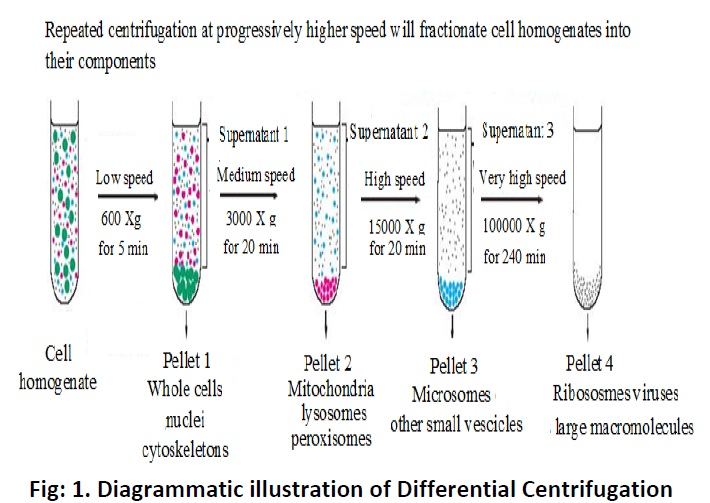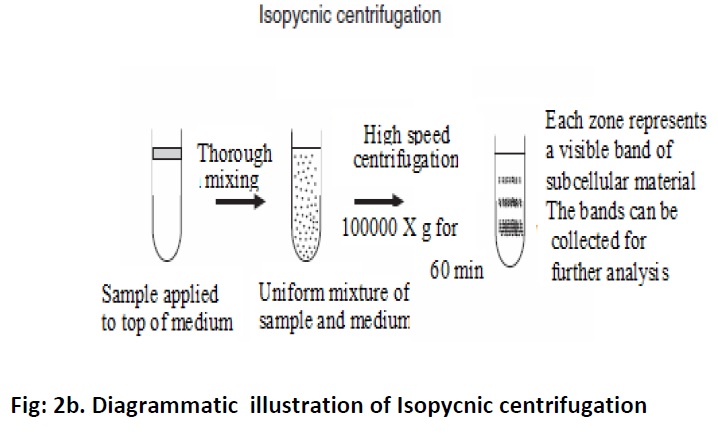Chapter: Basic Concept of Biotechnology : Macromolecules and Analytical Techniques
Centrifugation - Analysis of biomolecules
Analytical techniques
and applications
The analytical techniques have become the
integral part of any research and analysis of biomolecules. The brief
description of the analytical techniques is here with discussed.
Centrifugation
In 1923 Theodor Svedberg and his student H. Rinde had successfully analyzed large-grained sols by use of centrifugation. Centrifugation is a process used to separate particles or
concentratematerials such as cells, sub cellular organelles, viruses, proteins
and nucleic acids suspended in a liquid medium. The object moving in circle at
a steady angular velocity will experience a force F directed outwards; this is the basis of centrifugation. The
centrifugal force generated by a centrifuge is determined by the speed of
rotation and the distance of the sample from the axis of rotation. The
centrifugal force is usually compared to the force of gravity and is reported
as the relative centrifugal force (RCF) in g
units. (A force of 1 g is equal to the force of gravity at the earth's surface)
The following formula relates the RCF to the rotor speed and diameter: RCF = (1.119 x 10-5)* (rpm) 2
* r. whereris the radius of
rotation (the radius of the rotor)in cm and rpm is the centrifuge speed in revolutions per minute. The number
1.119 x 10-5 is a conversion factor that allows us to use "rpm" and "g" units. The RCF is dependent
upon the radius of the rotor, the speed at which it rotates, and the design of
the rotor itself (fixed angle or swinging bucket). Rotor speed and design can
be held constant, but the radius will vary from the top of a centrifuge tube to
the bottom. If a measurement for the radius is taken as the mid-point, or as an
average radius, and all forces are mathematically related to gravity, then one
obtains relative centrifugal force, labelled as g. The particles are separated with respect to their molecular
weight or saturation coefficient. The two common types of centrifugation are
analytical and preparative; the distinction between the two is based on the
purpose of centrifugation. Analytical centrifugation involves measuring the
physical properties of the sedimenting particles such as sedimentation
coefficient or molecular weight. Optical methods are used in analytical ultracentrifugation.
Molecules are observed by optical system during centrifugation, to allow
observation of macromolecules in solution as they move in gravitational field.
The other form of centrifugation is called preparative and the objective is to
isolate specific particles which can be reused. There are four basic types of
centrifuges viz:
Clinical
centrifuges, Microfuge, High speed centrifuges and Ultracentrifuges.
· Clinical centrifuges –Low
cost tabletop centrifuges that can runat a maximum speed of 4000-5000 rpm.
These can pellet cells, but not organelles or bio molecules. Two types of
rotors are used in it, fixed angle and swinging bucket. The separation can be
carried out in 10, 50 or 100 ml tubes.
· Microfuge -
These can typically run at a speed of up to 14,000rpm, sufficient speed to
pellet nucleic acids and denatured proteins. Microfuges can be used for small
volumes sample of 1-2ml.
· High speed centrifuges –These
operate at maximum speed of25,000 rpm or about 90000g, which is sufficient to
pellet cell nuclei and most bio molecules. However they are of little use in
isolating ribosome’s and microsomes etc. These are often refrigerated. High
speed centrifuges are used in more sophisticated biochemical application. Three
types of rotors are available for high speed centrifugation-fixed angle,
swinging bucket and vertical rotors.
Ultracentrifuges -
It can run at speeds up to 75,000 rpm,sufficient to allow fractionation of bio
molecules, for example: plasmid DNA, chromosomal DNA and RNA. It provides 5,
00,000g centrifugal force. The Ultracentrifuge is capable of reaching even
greater velocities and requires a vacuum to reduce friction andheating of the rotor.
The drive shaft on which rotor is mounted is merely 1/18th of an
inch in diameter. Shaft is made up of aluminium or titanium to withstand a
great force. Ultracentrifuges are usually refrigerated and are very expensive.
It is used for both preparative work and analytical work. The ultra centrifuge
can be classified into four types viz:
Differential centrifugation, Density gradient centrifugation, Zonal
centrifugation and Isopycnic centrifugation. In differential centrifugation
separation is carried out in a homogenous suspending medium. This is used to
isolate intracellular organelles. However the disadvantage is that the yield is
poor and the lighter particle near the heavier particle at the bottom also
sediment resulting in contamination.

In case of Density gradient
centrifugation it employs a medium which has gradient, generally a sucrose
density gradient, which is created by gently overlaying lower concentrations of
sucrose on higher concentrations in centrifuge tubes. The seperation under
centrifugal field is therefore dependent upon the buyont densities of the
particle. The particles travel through the gradient until they reach a point at
which their density matches with the density of surrounding sucrose. Then the
fraction is removed and analyzed. Gradient exert their seperating effect on
particle and also eliminate mixing of seperated components due to convention
and mechanical vibrations. There are two types in Density gradient centrifuge viz: Rate zonal (fig:2a and 2b) and
Isopycnic. In rate zonal centrifugationwhich is also known as band or gradient
centrifugation, a density gradient is created in a test tube with sucrose
having high density at the bottom. The gradient used here has maximum density
below that of least sedimenting particle.The sample particle travel throught
the steep gradient and form descreate zones depending upon their sedimentation
rate, difference in size and shape.This method is usefull for seperating
particle which differ in size but not in density.This is used for seperation of
RNA and DNA hybrids and ribosomal subunits. In Isopycnic centrifugation the
gradient used has greater densitiy than the most dense sedimenting
particles.Here centrifugation is done for prolonged periods at high speed to
permit all particle to seek this equilibrium density.It depend solely on the
buyont densities of the particle to be seperated and not on their shape or
size. Usually caesium chloride Dicoll (high molecular weight sucross polymer
and epichlorohydroxy ludox (silica sols) is used as a density gradient
material.


Generally the centrifuge is used in
clinical biochemistry, in production of bulk drugs, production of biological
product for e.g., bacterial enzymes are separated from bacterial culture medium
by sedimenting the bacterial cells by use of centrifugation. Dirt water is
separated from olive and fish liver oils. Evaluation of suspensions and
emulsions and determination of molecular weight of colloids.
Related Topics